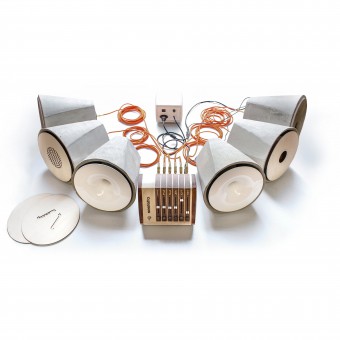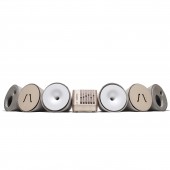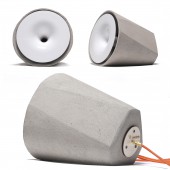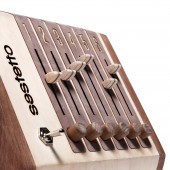
| THE AWARD |
| CATEGORIES |
| REGISTRATION |
| SUBMIT YOUR WORK |
| ENTRY INSTRUCTIONS |
| TERMS & CONDITIONS |
| PUBLICATIONS |
| DATES & FEES |
| METHODOLOGY |
| CONTACT |
| WINNERS |
| PRESS ROOM |
| GET INVOLVED |
| DESIGN PRIZE |
| DESIGN STORE |
| THE AWARD | JURY | CATEGORIES | REGISTRATION | PRESS | WINNERS | PUBLICATIONS | ENTRY INSTRUCTIONS |
Sestetto Speaker Orchestra by Stefano Ivan Scarascia |
Home > Winners > Design #56634 >Interview |
 |
|
FS: What is the main principle, idea and inspiration behind your design?
SS: The main aim of Sestetto was to allow the self-production of the listening experience of recorded music. The mixing of tracks and parts back to be physically in the place of listening, like in a real concert. In this way you can better distinguish the single voices and instruments that are usually merged in the common stereo premix offered by the traditional recorded music and audio players.
FS: What has been your main focus in designing this work? Especially what did you want to achieve?
SS: The main focus has been designing something able to be completely self-prototyped, while maintaining a proper aesthetic quality.
FS: What are your future plans for this award winning design?
SS: The first plan for Sestetto is to find music producers and distribution partners that believe in this next approach of the musical fruition, for its scale developments or just for interesting public and experimental performances. Smaller spin-off projects could follow it.
FS: How long did it take you to design this particular concept?
SS: The development of Sestetto - from its preliminary research and concept to the first prototypation - took around four months full time.
FS: Why did you design this particular concept? Was this design commissioned or did you decide to pursuit an inspiration?
SS: Sestetto has been freely developed, in the context of the “Autoproduzioni" self-production Final Synthesis Design Course held by teacher Stefano Maffei at the MA Degree of Product Design for Innovation in the Politecnico di Milano.
FS: Is your design being produced or used by another company, or do you plan to sell or lease the production rights or do you intent to produce your work yourself?
SS: At the moment one self-produced prototype performs as an unique piece of art installation. It also could be considered for Sestetto to be in the future sold/licensed to a worthy company.
FS: What made you design this particular type of work?
SS: The new technologies and systems were now ready for allowing the subverting of the usual constrictions of art fruition and distribution as like as the premixed recorded music.
FS: Who is the target customer for his design?
SS: Sestetto is mainly designed for Hi-End audio lovers, music passionates. It’s also designed to perform in theaters, schools and music venues.
FS: What sets this design apart from other similar or resembling concepts?
SS: In the past, there have been developed several other multichannel systems, but none of them was designed to reproduce the individual instruments in dedicated speakers. Far from the usual spatial surround applications of the past systems, the console of sestetto is designed for this particular musical use, equipped with the experimental speakers made of different materials and technologies dedicated to the specified recorded instrument.
FS: How did you come up with the name for this design? What does it mean?
SS: Sestetto is the italian word used to mean an orchestral ensemble of six musicians, like its six independent musical speakers.
FS: Who did you collaborate with for this design? Did you work with people with technical / specialized skills?
SS: The shiny ceramic horns of the ceramic speakers have been realized by Ceramiche Milesi artisanal workshop, well following the original drawings.
FS: What is the role of technology in this particular design?
SS: First of all, the digital technologies allowed sestetto to play six separate channels at the same time, with a D/A converter before the amplifier, the vibration speakers make the wood resonating in the wooden speakers. Talking about production, except of some digital fabrication technologies such the lasercut of the wood details, the rest of the production has been completely traditional and analog, from the wood manufacturings to the concrete moulding.
FS: How did you decide to submit your design to an international design competition?
SS: Although at the moment there’s only one physical prototype of Sestetto, it’s been shown in several exhibitions and performances with success. It attracted design magazines and recently a proposal for a big international exhibition. The time was so ready for trying an international design competition.
FS: What did you learn or how did you improve yourself during the designing of this work?
SS: The main teaching of Sestetto has been to follow all of the product development process, from its concept to the self-production of a working prototype. Working now with companies and factories, it’s so useful to know the production issues thank to a little but complete experience like this.
FS: Thank you for providing us with this opportunity to interview you.
A' Design Award and Competitions grants rights to press members and bloggers to use parts of this interview. This interview is provided as it is; DesignPRWire and A' Design Award and Competitions cannot be held responsible for the answers given by participating designers.
| SOCIAL |
| + Add to Likes / Favorites | Send to My Email | Comment | View Press-Release | Translations |





